OHIO COOPERATIVE


Fair fare Festival food flashbacks





ALSO INSIDE
Sunny and hot, with a chance of blackouts




POWs of Camp Perry
All about lightning bugs



















ALSO INSIDE
Sunny and hot, with a chance of blackouts




POWs of Camp Perry
All about lightning bugs











We united to get reliable electricity in 1935, and Ohio’s electric cooperatives fight to keep it today. It’s our #1 priority.



R.E.A.L. Value



22 NATURE’S FIREWORKS
The blinking of fireflies on a summer night evokes a sense of wonder in people of all ages.

24 FIELD OF DREAMS
Farming allows a Mechanicsburg mom to ‘live the best of both worlds.’
27 PERRY’S PRISONERS
Camp Perry, on the shores of Lake Erie near Port Clinton, was a major prisoner-of-war camp during World War II.


The concept of energy independence is complicated. In the U.S., we’ve generally talked about it in reference to oil and gasoline, but in fact, there are many more forms of energy that matter to our security, safety, and general well-being. In addition to oil and gasoline, for example, we need things like natural gas supplies and electricity derived from a variety of sources.
It’s easy to observe the negative effects that energy dependence has had on much of Europe over the past year. The higher prices, uncertain availability, political threats, and sabotaged infrastructure we’ve seen there all seem like problems we would like to avoid. But independence also has a price. Yes, it requires investment in things like infrastructure, mining, drilling, and fracking — but it’s not only monetary; all of those things also come with environmental impacts that no one wants in their own backyard but must be considered in any calculation of their overall cost.
Our electric system is immensely complicated as well. It consists of thousands of power plants owned by countless companies and organizations — public utilities, municipal utilities, independent power producers, private equity funds, federal agencies, and even not-for-profit electric cooperatives. And each of those plants requires its own specific fuel, ranging from coal, nuclear fuel, or natural gas to sunshine, wind, or water, to generate power, feed it into the transmission grid, and ultimately deliver it to local distribution systems like your electric cooperative, which then deliver that electricity to your home or business.
There is some oversight by system operators, which set operating parameters and monitor system conditions, but there is little a system operator can do once supply shortages occur. So having excess reserves helps take stress out of the system. Unfortunately, we’ve seen the reserves in our electric supply system dwindle in recent years, threatening the reliability and resiliency of our system, especially under extreme conditions.
Independence is never free, and that’s true of energy independence as well. It requires ongoing investments and long-term commitments to dependable infrastructure. While electric cooperatives are committed to doing our part to build and maintain reliable and dependable systems, energy independence is dependent on each actor in the system doing their part for every minute of every day. Our independence still depends on others.
Thanks for your support of your electric cooperative. We wish you and yours a safe and happy Independence Day.






 Pat O’Loughlin PRESIDENT & CEO OHIO’S ELECTRIC COOPERATIVES
Pat O’Loughlin PRESIDENT & CEO OHIO’S ELECTRIC COOPERATIVES

Energy independence is dependent on every actor in the system doing their part for every minute of every day.

6677 Busch Blvd. Columbus, OH 43229 614-846-5757
www.ohiocoopliving.com


Patrick O’Loughlin President & CEO
Caryn Whitney Director of Communications
Jeff McCallister Managing Editor
Amy Howat Associate Editor
Crystal Pomeroy Graphic Designer
Contributors: Colleen Romick Clark, Victoria Ellwood, Getty Images, W.H. “Chip” Gross, Catherine Murray, and Craig Springer.
OHIO COOPERATIVE LIVING (USPS 134-760; ISSN 2572-049X) is published monthly by Ohio Rural Electric Cooperatives, Inc. It is the official communication link between the electric cooperatives in Ohio and West Virginia and their members. Subscription cost for members ranges from $5.52 to $6.96 per year, paid from equity accruing to the member.
POSTMASTER: Send address changes to editorial and advertising offices at: 6677 Busch Boulevard, Columbus, OH 43229-1101. Periodicals postage paid at Pontiac, IL 61764, and at additional mailing offices. Nothing in this publication may be reproduced in any manner without written permission from Ohio Rural Electric Cooperatives, Inc. All rights reserved. The fact that a product is advertised in Ohio Cooperative Living should not be taken as an endorsement. If you find an advertisement misleading or a product unsatisfactory, please notify us or the Ohio Attorney General’s Office, Consumer Protection Section, 30 E. Broad St., Columbus, OH 43215. Periodicals postage paid at Columbus, OH, and at additional mailing offices.
4 POWER LINES
Summer forecast: Weather extremes and tightening electricity supply bring an increased chance of summer blackouts.
8 CO-OP PEOPLE

On target: His job’s safety focus and attention to detail translate perfectly to one co-op lineworker’s hobby.

10 WOODS, WATERS, AND WILDLIFE

Conservation corps: Appalachia Ohio Alliance members are used to getting their hands dirty for a cause.



13 GOOD EATS
Do yourself a flavor: Rubs and marinades add a powerful punch to everyday food.

17 LOCAL PAGES
News and other important information from your electric cooperative.
33 CALENDAR
8



National/regional advertising inquiries, contact Cheryl Solomon
American MainStreet Publications 847-749-4875 | cheryl@amp.coop
Please report changes of address to your electric cooperative. Ohio Cooperative Living staff cannot process address changes.
Alliance for Audited Media Member
36
10
photos and find content
What’s happening: July/August events and other things to do around Ohio.

Fair food: Members share shots of their favorite festival fare.

13
33
36

In June of 2022, after fierce storms ripped through the region, areas in and around Columbus were hit with power outages. Residents flocked to cooling centers as temperatures soared into the 90s. Animal shelters begged for donations of ice to relieve overheated dogs, and two local hospitals ran on backup generators.
Six months later, during the bitter chill of Winter Storm Elliott, consumers in Kentucky and eight other states experienced interruptions to their electric service.
In both cases, many of the outages were not due directly to the extreme weather events, but were mandated by the regional grid operator to quickly reduce electricity consumption and maintain the necessary balance between supply and demand.
That emergency balancing act is known by many names, including “intermittent outage” or “forced outage,” but is most commonly called a “rolling blackout.” It can happen when a peak in electricity use — usually during extremely hot or extremely cold weather — coincides with significant gaps in the generation or transmission of electricity, says Ben Wilson, director of power delivery engineering for Buckeye Power, which supplies electricity to Ohio’s electric cooperatives.
“It’s always a possibility, but it takes a perfect storm of factors converging to get us to that point,” Wilson says.

“Rolling blackouts are a last resort when the normal lines of defense have failed.”





Rolling blackouts reduce demand on the stressed electrical grid to prevent wider outages. “We could be called upon to reduce, say, 5% of load or we all risk blackouts,” he says. “Co-ops have plans in place if this happens. We’re not going to cut power to hospitals or prisons. If it’s going to be sustained, we’ll cycle it, restoring power to some areas while cutting it somewhere else.”
The good news is that rolling blackouts happen rarely. The bad news is that a convergence of factors, including increased electrification and reduction in reliable power generation, is reducing the surplus of available electricity, closing the gap between supply and demand.
“The risk is higher now than it was five years ago, and it will continue to be elevated until more generation comes online,” Wilson says. “In the next three to five years, at least, we’ll be living with that elevated risk in summer and winter months.”
The North American Electric Reliability Corporation, an industry organization charged with assessing and improving the reliability of electricity, has warned of an elevated risk of electricity shortfalls for about twothirds of the U.S. this summer during periods of low wind or drought along with extreme temperatures.
Outage: Any loss of power to an area is an outage. The vast majority of outages are unplanned and limited to a specific area. Most are caused by trees hitting power lines, small animals, or even vehicles crashing into utility poles. High winds and storms increase the likelihood of such outages. Occasionally, a local utility will plan an outage to do repairs or upgrades to its electric distribution infrastructure. Consumers generally receive prior notice for a planned outage.
Thankfully, the outlook for Ohio is a little less urgent, says Asim Haque, vice president for state policy and member services for PJM Interconnection, which is responsible for the part of the electric grid that includes Ohio. Because the region still has higher baseload capacity from coal and natural gas plants, the worstcase scenarios of demand outstripping supply are less likely here, at least for now.



“If you look at the NERC summer assessment, we’re not one of the more volatile areas that the report identifies,” Haque says. “But the states that border us are. We’re very concerned about whether we’ll continue to have adequate resources later in this decade.”
A strain on the supply of available electricity can come from inadequate power generation or from problems with transmission, says Tom Schmidt, principal planning engineer for Buckeye Power.
It was a culmination of transmission problems, in fact, that led to the events last June. “Some planned outages weren’t wrapped up in May, as they were supposed to have been,” Schmidt says. “Power lines were under construction or being upgraded, so that was the first line of defense down. The second was
Sometimes called a “forced outage” or an “intermittent power interruption,” a “rolling blackout” is a systematic outage implemented by electric utilities to reduce total electricity usage at times of exceptionally high demand when the supply of available electricity falls short, or the means to transmit it to areas where it’s needed are compromised. Generally, power to an area is shut off for a specified time, then restored as another area is shut off, to limit the outage duration for each area.
the storms that rolled through, taking additional lines down, and then extreme heat came in on top of that.”
Any one of those problems wouldn’t be nearly enough to necessitate rolling blackouts, Wilson says. “A 100year heat, a storm, or an outage issue alone wouldn’t do it,” he says. “It just all happened at the same time.”




In December 2022, the shortfall came in generation and affected a much wider area, Wilson says. The winter storm brought sudden extreme cold, and some natural gas plants experienced problems and didn’t come online quickly enough to meet the jump in demand.
“There was not enough power generated for the power consumed,” he says. “It was a different path to the same conclusion. Users were asked to curtail load across multiple states.”



In Kentucky, five electric co-ops were among the utilities asked to reduce energy use, says Joe Arnold, vice president for strategic communications for Kentucky Electric Cooperatives. “Utilities asked account holders to cut back on unnecessary power use, and some had to take the extraordinary step of creating short, temporary power outages,” he says. “The co-ops did everything they could to protect the grid and minimize disruption to their members.
Continued on page 6
Brownout: A lowering of voltage in the electric system is called a “brownout” because incandescent lightbulbs will dim with less voltage. Grid operators may purposely lower voltage to slightly reduce system loading (called “voltage regulation”) but are required to maintain an acceptable level because voltage that’s too low can damage equipment. At times, consumers may observe low voltage during periods of especially high demand, but those brownouts are not intentional, perhaps the result of equipment failure or insufficient voltage regulation.
Utilizing social media and news media, the affected co-ops kept members updated as much as possible during the event.”
Ohio’s co-ops are likewise prepared, and should the need for conservation or forced outages arise, they would communicate closely with their members, Wilson says.
The growing possibility of such shortfalls in generation is causing concern about electric reliability going forward, Haque says.
“We’re going to see demand increase on the system due to data centers and continued electrification, both in the auto industry and in homes,” he says. “Supply is dwindling, primarily because of state and federal policies that are prematurely pushing resources out of the generation mix.
“We are not seeing replacement generation come on at a rate to match the supply that is being forced out,” he says. “Thermal resources — coal, natural gas, and nuclear power — provide essential reliability services. If we’re pushing them off the system, we’ll have grid reliability issues. We need those thermal sources until replacement technology can be deployed at scale, whether that’s long-duration batteries for wind and solar, or small modular nuclear reactors.”
Simultaneous growth of demand and reduced supply means less redundancy, and a higher probability that demand will outstrip supply.
“We’re seeing loads increasing, but also generation going away more quickly than it can be replaced,” Wilson says. “We’re getting closer than we’d like to be with the amount of generation compared to the amount of load we might see during extreme weather.”
The primary driver, Haque says, is the rapid progression of environmental policy — from the Obama administration’s Clean Power Plan, which promoted use of natural gas to replace coal, to current policies aiming to eliminate all thermal sources.
“This is being done devoid of the reliability impact,” Haque says. “We need to slow down on retirements across the country, so we can continue to bring renewable resources online.”
The forecast going forward is even worse, as proposed new rules by the Environmental Protection Agency could force nearly all fossil fuel plants to shut down in the next decade.
“The rolling blackouts and calls for emergency curtailments in December should serve as a wake-up call to politicians and regulators who apparently take electric service for granted,” says Kentucky’s Arnold. “When policies discourage the most reliable energy sources, local electric consumers are the ones who pay the price.”
Reducing total demand for electricity can relieve stress on the grid and reduce the likelihood of rolling blackouts. Cooperative members can help by:
• Conserving electricity, particularly during peak times of the day (generally in the morning, as people are getting ready for work and school, and in the evening, from about 6 p.m. to 10 p.m.). This can include doing high-energy tasks, like charging electric vehicles and doing laundry, during off-peak times.
• Being aware of weather events that will stress the grid. Adjusting thermostats a bit higher in the summer and lower in the winter and making extra conservation efforts during extreme weather can make a difference.
• Participating in their utility’s load management system, which can save money and help cooperatives manage electricity use during the very highest usage peaks. Load management devices on electric water heaters and HVAC systems allow the co-op to turn power to the appliance off and on during the peak alert period. This means that, for instance, everyone’s air conditioners (which cycle on and off to maintain thermostat temperatures anyway) aren’t cycled on at the same time, evening out the highest demand peaks and relieving some of the pressure on the grid.
Don’t be so demanding!




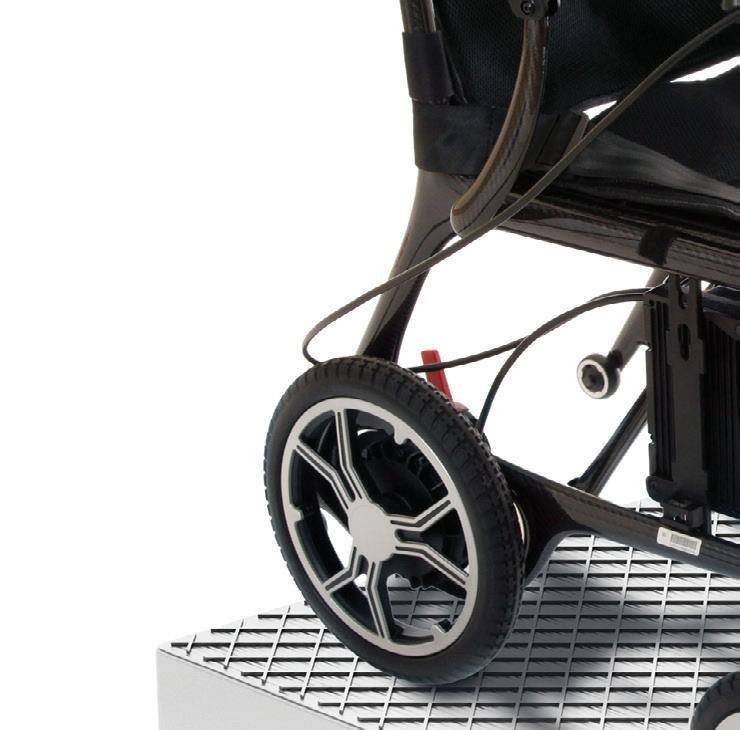

























 BY VICTORIA ELLWOOD
BY VICTORIA ELLWOOD

At first glance, shooting clay pigeons and working on electric power lines may not seem to have a lot in common. But Dave Salmons, who’s no stranger to either endeavor, sees some definite commonalities.

Salmons is a first-class lineworker with 35 years of line work under his belt, the longest-serving lineman currently working at Logan County Electric Cooperative in Bellefontaine. He says it’s the day-to-day challenges and camaraderie with his team that keep him going.
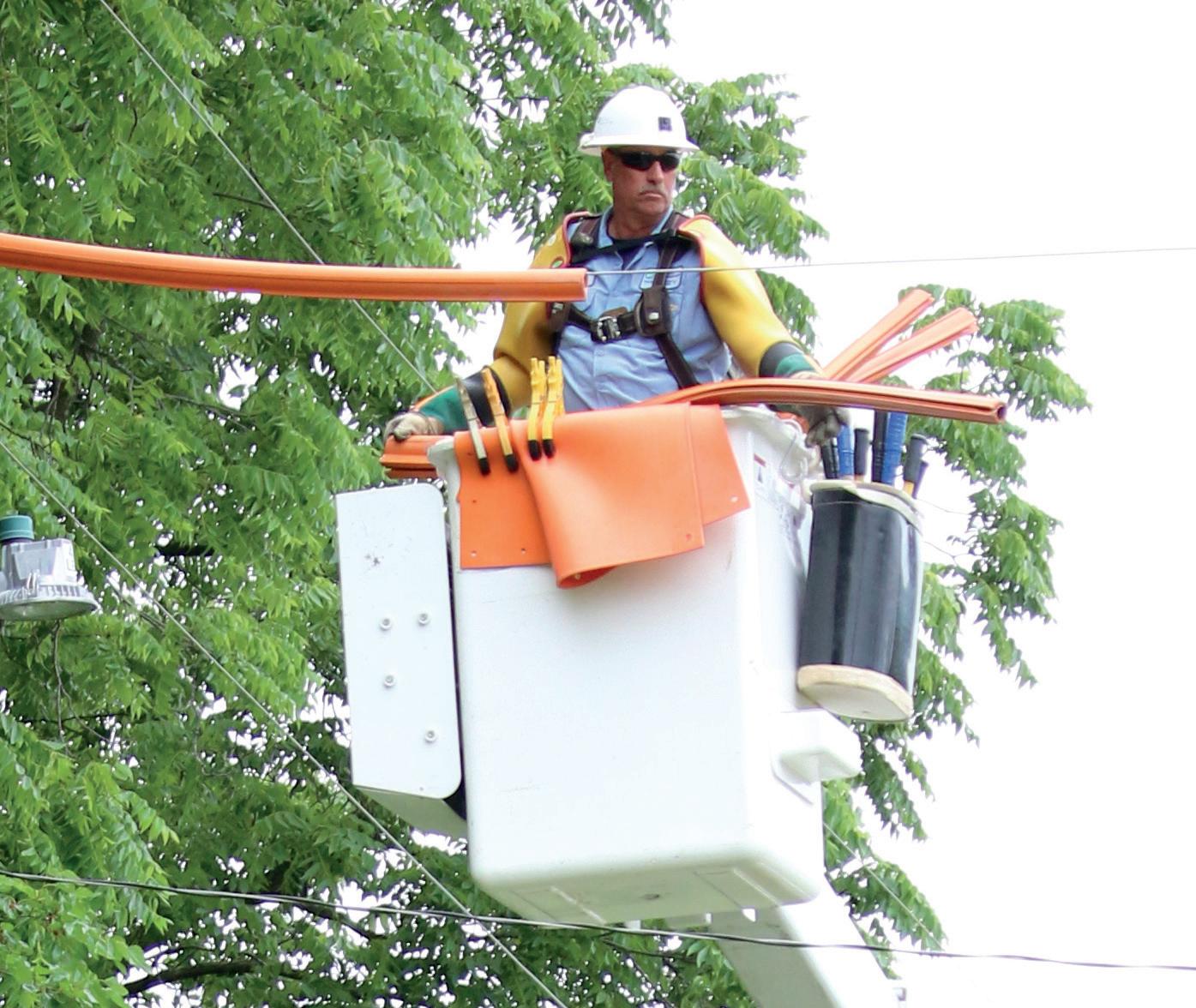
You might say those same work aspects — along with a paramount focus on safety and propensity for braving the elements — also apply to Salmons’ hobby of shooting sporting clays.



Salmons picked up the hobby about 17 years ago after visiting a local fish and game club, and quickly found it got his competitive juices flowing. Competitors walk through the woods, stopping at stations where they take aim at clay “birds” — targets mechanically thrown into the air.
Each competitor shoots 50 targets, keeping score and trying to improve over time.
“We have a group of six or seven guys that get together,” he says. “We don’t shoot in the big state tournaments or anything like that, but we have three gun clubs within 30 minutes of us, so we have a traveling rotation of those courses that allows us to shoot almost every weekend. We’re pretty competitive just among us; we have our own traveling trophy and everything.”
Like co-op line work, he says, “Safety is paramount. We’ve been shooting together for years, and if one of us steps out of the station and doesn’t (safely) open his gun, the rest of the guys are watching.”




It’s the same on the job, where all the lineworkers — seasoned veterans and younger ones alike — watch out for one another, he says. “The camaraderie we have with each other is important,” he says. “We may joke around, but we take things seriously, too.”
Salmons’ group heads out most weekends, in all sorts of weather. “We shoot if it’s raining or snowing,” he says. “We’ve even been out there when it’s 4 below zero. We can be pretty ‘die-hard.’”
Salmons and his wife, Marna, a retired fourth-grade teacher at Indian Lake Elementary in Lewistown, were high school sweethearts at Elgin High School in Marion. They have two grown sons: Colman, 34, a supervisor at Amazon in Columbus; and Mark, 31, a supervisor at Midwest Express in East Liberty.
When he’s not working on power lines or out shooting with his group, Salmons also enjoys a bit of woodworking, but lately, he’s found another pursuit that’s taking up more and more of his time.
“We have three grandkids, and another on the way this month,” Salmons says. “We’re learning that, as grandparents, you can’t ever get enough time with your grandkids, but they’re nearby, so we try to test that as much as we can.”
Dave Salmons says his job as a lineworker at Logan County Electric Cooperative is similar to his hobby because both require intense concentration on safety. Dave Salmons (opposite page, with the trophy that gets passed around among the friends in his shooting group) enjoys the camaraderie that’s an integral part of both his work and his hobby.Job’s safety focus, attention to detail translate perfectly to lineworker’s hobby.




 STORY AND PHOTOS BY W.H. “CHIP” GROSS
STORY AND PHOTOS BY W.H. “CHIP” GROSS
Some natural resources conservation groups talk a good game. Others diligently and quietly go about their stated mission, making a decided difference in the out-of-doors year by year, decade after decade. Appalachia Ohio Alliance is definitely one of the latter.
“AOA is a private, nonprofit land conservancy organization, one of 1,700 in the United States,” says the alliance’s director, Steve Fleegal. “We cover most of central and southeast Ohio, with a focus on maintaining and improving water quality in four areas: the Scioto River, Big Darby Creek, the Hocking River, and Hocking Hills.”
It’s not the group’s only focus, of course; the group also works to preserve Native American sites, cultural heritage sites, historic farms, and geologic features across the region.








To get a feel for AOA, I tagged along on one of the organization’s many annual educational events open to the public. The field trip attracted some 30 people to Cedar Bog Nature Preserve, a few miles south of Urbana. It’s the oldest nature preserve in the Buckeye State purchased with state funds (in 1942), and is owned, operated, and managed by the Ohio History Connection.





During its 20 years of existence, Appalachia Ohio Alliance has totaled an impressive list of accomplishments. Among them:

15,000+ Number of acres conserved






164 Number of properties conserved

32 Number of conservation preserves

19 Number of Ohio counties involved
I had an added incentive for attending the leisurely guided hike along the mile-long boardwalk that spans the bog. I’d always wanted to photograph one of Ohio’s rarest and most spectacular spring wildflowers: the showy lady’s slipper orchid, which blooms in late May and early June. Cedar Bog did not disappoint.
Other annual AOA nature-based field trips — some 25 or so per year — include spring birding hikes, summer creek explorations, and fall Monarch butterfly tagging. One of their more popular mid-summer events is always the canoe and kayak float down a state scenic river, where participants make frequent stops along the route to seine fish and other aquatic critters, which are identified and released.
“The goal of our field trips is to get people out onto the land to enjoy our properties,” Fleegal says. “After all, we’re conserving these sites for public benefit. And kids are always welcome.”
The alliance also hosts two dozen or so yearly “stewardship events” — hands-on, get-grubby work details where volunteers improve AOA preserves. Volunteers work to eradicate invasive non-native plants such as Japanese honeysuckle, multi-flora rose, tree of heaven, autumn olive, and garlic mustard. They also conduct controlled burns to maintain prairie openings, plant native
Whether you’re looking for a fun, safe field trip for you and your family, or you’re ready to volunteer and get your hands dirty for conservation, Appalachia Ohio Alliance is a worthwhile organization with a proven track record spanning two decades. Their members make a difference for Ohio’s outdoor future. To get involved, go to www.appalachiaohioalliance.org.
tree seedlings, and reintroduce declining wildflower species such as yellow lady slipper orchids and forest medicinal plants to their former habitats.
One of AOA’s largest ongoing projects is the acquisition of Bison Hollow Preserve in the Hocking Hills region. Located south of Ash Cave at Hocking Hills State Park, Bison Hollow straddles the Hocking-Vinton county line and, according to Ken Mettler, an AOA board member, is an important component of AOA’s Greater Hocking Hills Conservation Initiative. “The total area protected is now over 660 acres.”
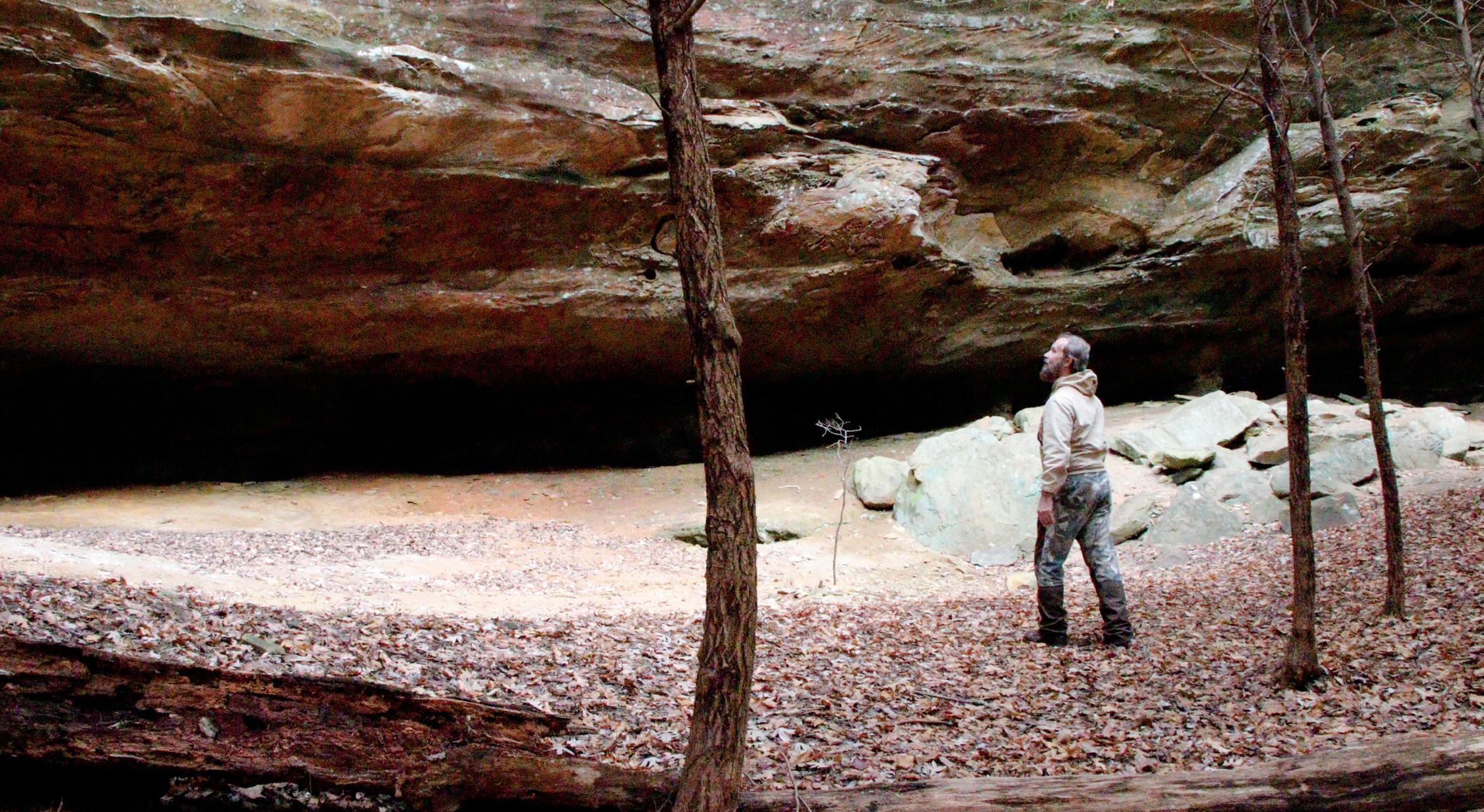
W.H. “Chip” Gross is Ohio Cooperative Living’s outdoors editor. Email him with your outdoors questions at whchipgross@gmail.com. Be sure to include “Ask Chip” in the subject of the email. Your question may be answered on www.ohiocoopliving.com!
www.ohiocoopliving.com


















































































Rubs
Have you tried one of our recipes? Do you have a recipe to share with other Ohio co-op members? Visit the Member Interactive page on www.ohiocoopliving.com to find recipes submitted by our readers and to upload yours.
www.ohiocoopliving.com





While you’re there, check out a video of a few of our recipes being prepared.






Prep: 25 minutes | Chill: 1 to 24 hours | Cook: 10 minutes |

Servings: 4

1 pound extra-firm tofu
2⁄3 cup honey
1⁄2 cup apple cider vinegar
2 tablespoons low-sodium soy sauce







2 tablespoons ketchup
1 tablespoon sesame oil
1 clove garlic, minced
1 teaspoon ground ginger
1⁄2 teaspoon red pepper flakes
1 small carrot, grated
1 small onion, diced
1 cup diced red and/or green pepper
2 teaspoons cornstarch


1 tablespoon water
2 cups cooked rice
Press tofu between two clean towels with a weight on top for 20 minutes. (A cast-iron skillet works well.) In a large container with lid, mix together honey, vinegar, soy sauce, ketchup, sesame oil, garlic, ginger, red pepper flakes, and grated carrot. Cut tofu into 1-inch cubes and toss to coat with marinade. Cover container and place in fridge for at least an hour and as long as 24 hours.
Spray a large skillet with cooking spray and lightly sauté onion and pepper over medium-high heat for 3 to 4 minutes, then transfer them into a bowl to cool. Spray skillet again, then toss in tofu, reserving the majority of the marinade for now. Let the tofu brown and caramelize a bit on each side, then pour in the marinade. In a small bowl, mix cornstarch with water, then pour into marinade. Continually stir until sauce thickens. Mix in pepper and onions, cooking another minute. Serve over rice. Per serving: 496 calories, 9 grams fat (2 grams saturated fat), 0 milligrams cholesterol, 554 milligrams sodium, 95 grams total carbohydrates, 3 grams fiber, 14 grams protein.
and marinades add a powerful punch to everyday food.
Tandoori chicken is a well-known Indian dish usually cooked in a tandoor (a charcoal or wood-burning clay oven), but this recipe is made in a conventional oven. Even though all the spices would make a great dry rub, the lime and Greek yogurt make the chicken extra moist and tender.

Prep: 20 minutes | Cook: 45 minutes | Servings: 8
1 cup plain Greek yogurt
5 cloves garlic, minced
2 tablespoons olive oil
1 lime, zested and juiced
1 tablespoon grated ginger
1 tablespoon garam masala
2 teaspoons chili powder
2 teaspoons cumin
1 teaspoon paprika or smoked paprika
2 teaspoons coriander powder
1 teaspoon turmeric powder
1 teaspoon salt
½ teaspoon cayenne pepper
3 to 4 pounds chicken drumsticks and thighs (skinless, bone-in)
Raita Sauce (optional)
¾ cup yogurt or sour cream
¼ cup finely chopped cucumber
2 tablespoons chopped cilantro
½ teaspoon cumin
½ teaspoon garam masala
¼ teaspoon salt
Mix ingredients to make raita, if using, and refrigerate. Mix all remaining ingredients except chicken in a large container with a lid. Pat chicken pieces dry, then deeply score with a paring knife for the chicken to absorb the marinade. Generously coat chicken in marinade, cover, and refrigerate for 6 to 24 hours.
Preheat oven to 450 F. Line a baking tray with foil and place an oven-safe metal rack on top. Spray rack with cooking spray. Lay coated chicken pieces on rack, leaving some space in between them. Roast on middle rack 20 minutes, flip chicken, then roast another 20 to 25 minutes, until cooked through. Broil for 5 to 7 minutes until lightly charred. Serve hot, with raita and naan bread if desired.
Per serving: 380 calories, 24 grams fat (7 grams saturated fat), 180 milligrams cholesterol, 536 milligrams sodium, 4 grams total carbohydrates, 1 gram fiber, 41 grams protein.
Prep: 10 minutes | Cook: 12 minutes | Servings: 4
1 tablespoon packed brown sugar
1 teaspoon paprika
½ teaspoon garlic powder
½ teaspoon onion powder
½ teaspoon mustard powder
½ teaspoon salt
¼ teaspoon pepper
1 tablespoon olive oil
1 pound salmon fillets
This salmon can be baked, pan fried, or (as shown) grilled. In a small bowl, mix together all dry ingredients. Rub salmon with olive oil, then rub in the spices. Let rest for 15 minutes. Heat grill to medium, then spray with cooking spray. Lay salmon on the grill flesh side down until charred opaque, 2 to 3 minutes. Flip so skin side is down and cook another 6 to 8 minutes, to the preferred doneness. Serve with favorite vegetables and side dishes. Per serving: 196 calories, 11 grams fat (1.5 grams saturated fat), 50 milligrams cholesterol, 342 milligrams sodium, 3 grams total carbohydrates, 0 grams fiber, 22 grams protein.

Prep: 20 minutes | Marinate: 8 to 12 hours |
Cook: 15 minutes | Servings: 8
2-pound flank or skirt steak

20-ounce can sliced pineapple
1 large lime, juiced and zested
1 tablespoon honey
1 tablespoon grated ginger
2 cloves garlic, minced
1 teaspoon salt
1 pint cherry tomatoes, halved
1 avocado, diced ¼ cup red onion, finely diced 5 ounces arugula
Drain juice from canned pineapple into a medium bowl, then whisk together with honey, lime juice, lime zest, ginger, garlic, and salt. Pour half the marinade over the steak in a ziplock bag and reserve the rest as a dressing for the salad later. Zip bag and shake to coat steak. Refrigerate steak, dressing, and pineapple slices overnight. Set grill to medium-high and spray with cooking spray. Remove steak from marinade and lightly shake off excess. Use metal tongs to place steak and pineapple slices flat on the grill. Close lid and grill pineapple slices for 3 minutes and steak for 5 to 9 minutes on each side. Check for an internal temperature of 135 F on the thickest part of the steak for medium-rare. Steak will continue to cook once removed, by about 5 degrees. Let rest before slicing against the grain. Prep salad by tossing tomatoes, avocado, onion, and arugula with the reserved dressing. Per serving: 346 calories, 17 grams fat, 5.5 grams saturated fat), 67 milligrams cholesterol, 387 milligrams sodium, 18 grams total carbohydrates, 4 grams fiber, 32 grams protein.
How can a rechargeable hearing aid that ts inside your ear and costs only $14 999 be every bit as good as one that sells for $2,400 or more?





The answer: Although tremendous strides have been made in Hearing Aid Technology, those cost reductions have not been passed on to you. Until now...
























The MDHearing™ NEO uses the same kind of technology incorporated into hearing aids that cost thousands more at a small fraction of the price. Over 800,000 satis ed MDHearing customers agree: High-quality, digital, FDA-registered rechargeable hearing aids don’t have to cost a fortune. NEO is a medical-grade, digital, rechargeable hearing aid offering sophistication and high performance; and works right out of the box with no time consuming “adjustment” appointments. You can contact a licensed hearing specialist conveniently online or by phone — even after your purchase at no cost. No other company provides such extensive support. Now that you know...why pay more?
PLUS... It fits inside your ear.










Hancock-Wood Electric and our members value the reliability of electricity; it is our No. 1 priority because our lives and livelihoods depend on it. Yet the EPA has recently released new proposed rules that pose the greatest threat to the reliability of our electrical grid that we’ve seen in our nation’s history.
Our statewide organization, Ohio’s Electric Cooperatives, has been warning for months that electricity reliability has been under threat. Grid operators and regulators have issued the same warnings, but the EPA appears not to be listening. e new proposed EPA rules released ursday, May 11, would all but ban the use of fossil fuels to produce electricity by forcing most, if not all, coal and natural gas plants into early retirement, eliminating the reliable, baseload power generation that fossil fuels provide to our electrical grid. Fossil fuel power generation is the foundation of electricity production because it is always available, 24 hours a day, seven days as week, 365 days a year, at an a ordable cost for consumers.
Our electric power system works on the principles of science and engineering and people of all political persuasions depend on a reliable supply of electricity for our health, safety, and security. Unfortunately, we will need to ght our federal government for many months and likely years to avoid the harmful e ects of this unrealistic plan.
Jim Matheson, CEO of the National Rural Electric Cooperative Association (NRECA), issued a statement in response to the EPA’s latest proposed rule to regulate power plant emissions: “ is proposal will further strain America’s electric grid and undermine decades of work to reliably keep the lights on across the nation,” Matheson said. “And it is just the latest instance of EPA failing to prioritize reliable electricity as a fundamental expectation of American consumers. We’re concerned the proposal could disrupt domestic energy security, force critical always-available power plants into early retirement, and make new natural gas plants exceedingly di cult to permit, site, and build.”
Bill Barnhart PRESIDENT & CEO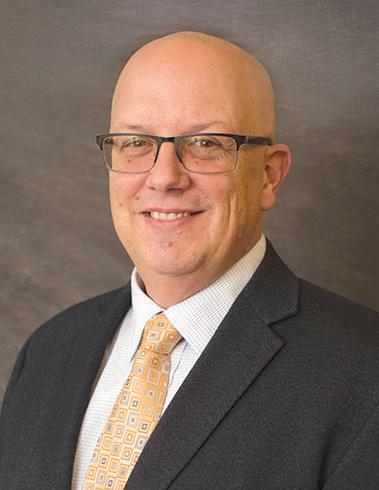
“Nine states experienced rolling blackouts last December as the demand for electricity exceeded the available supply. ose situations will become even more frequent if EPA continues to cra rules without any apparent consideration of impacts on electric grid reliability,” Matheson said. “American families and businesses rightfully expect the lights to stay on at a price they can a ord. EPA needs to recognize the impact this proposal will have on the future of reliable energy before it’s too late.”

In May, Hancock-Wood Electric hosted an EV Cars and Coffee event at our office in North Baltimore. Our energy experts were available to answer any questions members had about electric vehicles and have an open discussion. HWE recognizes that many members are considering electric vehicle options. One purpose of this event was to provide information about EV charging and electrical requirements to our members so they can make informed decisions about EVs. Members can save with our new time-of-day rates by charging their EV off-peak from 10 p.m. to 6 a.m. No matter what our members drive, we want to help you achieve energy savings. More information can be found on our website, www.hwe.coop.
We would also like to thank the Reineke Family Dealerships, which brought the F-150 Lightning ER and the Mustang Mach-E to the event.

Recently, Board Member Duane Fry completed his Board Leadership Certification. In order to fulfill duties, HWE trustees achieve varying levels of certification through the National Rural Electric Cooperative Association. HWE encourages all its trustees to earn these certifications because the coursework required dramatically broadens a trustee’s knowledge of the electric cooperative industry, thereby enhancing his or her value to all HWE’s member-consumers. All electric cooperatives in the U.S. utilize similar training. The first required certificate is the Credentialed Cooperative Director certificate (CCD), which covers director duties, board operation, strategic planning, and more. After receiving the CCD, the trustee then goes on to the Board Leadership Certificate (BLC), which specializes in power supply, the cooperative business model, technology and more. The final certification is the Director Gold Credential, which is required to be completed every two years.

High school students from four Ohio electric cooperative territories received the rare opportunity to tour the Cardinal Power Plant, considered one of the world’s cleanest power-producing coal plants in the world. Cardinal Plant will soon be only one of four coal plants still operating in the state due to overreaching EPA regulations that have forced many coal plants into early retirement.
A total of 127 students from Ohio cooperatives took part in the half-day tour. Participating were Findlay High School and Millstream Career Center (Hancock-Wood Electric Cooperative); Fairbanks High School (Union Rural Electric – URE); Sheridan High School (South Central Power); and New London High School (Firelands Electric Cooperative).
“It’s important to show students there are a lot of career opportunities in the cooperative world,” said Coty Lee, safety and health supervisor at the Cardinal Plant. Some opportunities can be pursued right out of high school, and some after college, in many areas, including engineering, finance, IT, communications, human resources, line work, customer service.
The students were first shown a video to better understand the history of how not-for-profit electric cooperatives formed in Ohio in 1935 under the Rural Electrification Act. The purpose was to bring electricity outside the cities, and into the rural agricultural areas of Ohio. Students also learned how the cooperatives’ Buckeye Power, which owns Cardinal Plant, believes in an all-of-the-above approach to power generation, including coal, natural gas, solar, wind, hydropower, and biofuels. Coal is the baseload source of power generation because it is reliable and always available.
The students were given a guided walking tour inside the plant, which produces 1800 megawatts of power, enough to light 200 million LED lightbulbs. They saw firsthand how electricity is made from beginning to end. And how even the waste material left over, called fly ash, is sold, and used in the manufacturing of concrete products.
“Society pushes the narrative on young kids that coal is bad. It’s nice to have them on site so they can see a coal plant for themselves. When I was in college, all you would hear is move away from coal at all costs. You would never hear about all the jobs it offers, or the benefit of the sustainability and reliability of power generation behind it,” said Corey Seneff, IT systems analyst II.







In May, Hancock-Wood’s Community Trust Fund board approved two grant applications to local fire departments. Arlington Fire Department received $7,325 and Cygnet Fire Department received $7,890. These donations are made possible by our members who participate in the Operation Round Up Program. This program rounds bills up to the next dollar and those cents are collected and used to help fund projects in the communities we serve. To learn more about Operation Round Up visit www.hwe.coop/operation-round-hwe-community-trust-fund.


































 BY CRAIG SPRINGER
BY CRAIG SPRINGER
It’s the dog days of summer, when the air is close and sultry and the heat oppressive. The nasally drone of insects that go sight unseen comes at you, swarming, rising and falling, lapping like waves that come and go off a lake shore.
If summer sound had colors, they’d be matte — flat, like the noir filter on a smartphone camera, near featureless.

























































But that belies what nightfall brings. Sirius, the dog star, rises into view near the sun this time of year — a harbinger of the sweltering warmth sure to follow for several weeks. This also marks another illuminating event: the rise of fireflies.































More than 2,400 species of fireflies exist around the globe, including about two dozen that make a home in Ohio. Fireflies, or lightning bugs as some people call them, are not flies at all, but beetles characterized by heavily armored shells over wings.
When they take to the wing, they move about as though they carry a heavy load; speed through the air is not a defense mechanism. Heck, they advertise their whereabouts, from just above the grass to chesthigh to weaving through the treetops, for any wouldbe predator to swoop in and make them a snack.

The height where they fly may very well distinguish one species from another to the discerning eye. No matter the species’ name, they all have similar missions when their hindmost is lit: to find a mate and thereby create more fireflies. (The exception is the femme fatale in the Photuris genus of fireflies, among which the females use light for another purpose: to attract males of another genus and make a meal of the amorous suitors. Nature is fascinating — and brutal.)
Typically, it’s the male firefly that blinks to females that rest on the ground or among the boles of trees or in shrubbery. Some populations of fireflies turn the affair into a disco — synchronously flashing en masse,











































followed by a pause, then a random and chaotic display, a pregnant pause, then they start it all over again. How they communicate the timing is a curious matter, and it is a wondrous event to witness.
Fireflies are ordered by entomologists into the family Lampyridae , which makes sense if you think about it. The bioluminescent blinking bottom — the lamp — is the most distinguishing characteristic among a litany of beetles. The blink is made up entirely of chemical reactions wired in the nervous systems, and it gives off no heat. You might say it is energy efficient, yet it is a primitive technology eons old.
All of the fireflies around the world live in warm, humid climates. So while the sweltering heat of a Buckeye July may cause you to retreat to the AC, it’s what fireflies live for — literally — during the critical reproduction arc of their life cycle.




































































Fireflies spend most of their two-year life span on or in the ground as a grub, a wormlike creature living in







































































the forest leaf litter or in the fields plowing soil just below the surface. That’s where they turn soil or move through decaying leaves in search of food. These larval lamps eat worms, other grubs, snails, and bugs. Farmers appreciate firefly larvae because they keep down slugs and snails that otherwise sup on soybean seedlings fresh out of the ground.
With the coming rise of Sirius and the heat of summer’s swelter, they undergo one of the most remarkable wonders of nature: the metamorphosis that turns them into winged beetles. Adult fireflies live only about two months after they have reproduced.




The lumbering flight of fireflies makes them easy to catch — and to marvel over as they blink in your cupped hands. Their transformation from grub to blinking beetle evokes a sense of wonder in children from age 8 to 80 as the beetles put on their fireworks display, which will continue during evenings well past Independence Day.














Farming allows stay-at-home mom to ‘live the best of both worlds.’
STORY AND PHOTOGRAPHS BY VICTORIA ELLWOOD








With her quick smile and no-nonsense air, Brandi Anderson is warm and approachable, with two friendly St. Bernard dogs wagging their tails by her side. Beneath that cheerful exterior, she blends fierce determination, a readiness to develop new skills, and a love of demanding outdoor work to achieve what she wants for her family.
She’s also determined to help others know exactly where their food comes from.
Brandi owns Women That Farm (also known by its acronym, WTF), a farm that raises cattle, hogs, chickens, and turkeys to be butchered and sold locally.










































































































































































“If someone asks me what I do, the short answer is that I farm,” she says. “But if you dig a little deeper, this is my way to be both a stay-at-farm mom and provide an income for my family. I like to say I live the best of both worlds.”






























Her world includes her husband, Nick, three little girls (ages 6, 7, and 9), and, at any one time, more than 100 head of black Angus cattle, 48 turkeys, and 350 chickens, all on their 13-acre farm near Mechanicsburg. Hogs are kept at her sister-in-law’s farm down the road. They also have two bulls (with rings in their noses), three dogs, a horse, and a cute little pony just for fun. They also have land that serves as a storage facility for their semi-truck, farm equipment, and hay near Urbana, where they are members of Pioneer Electric Cooperative.
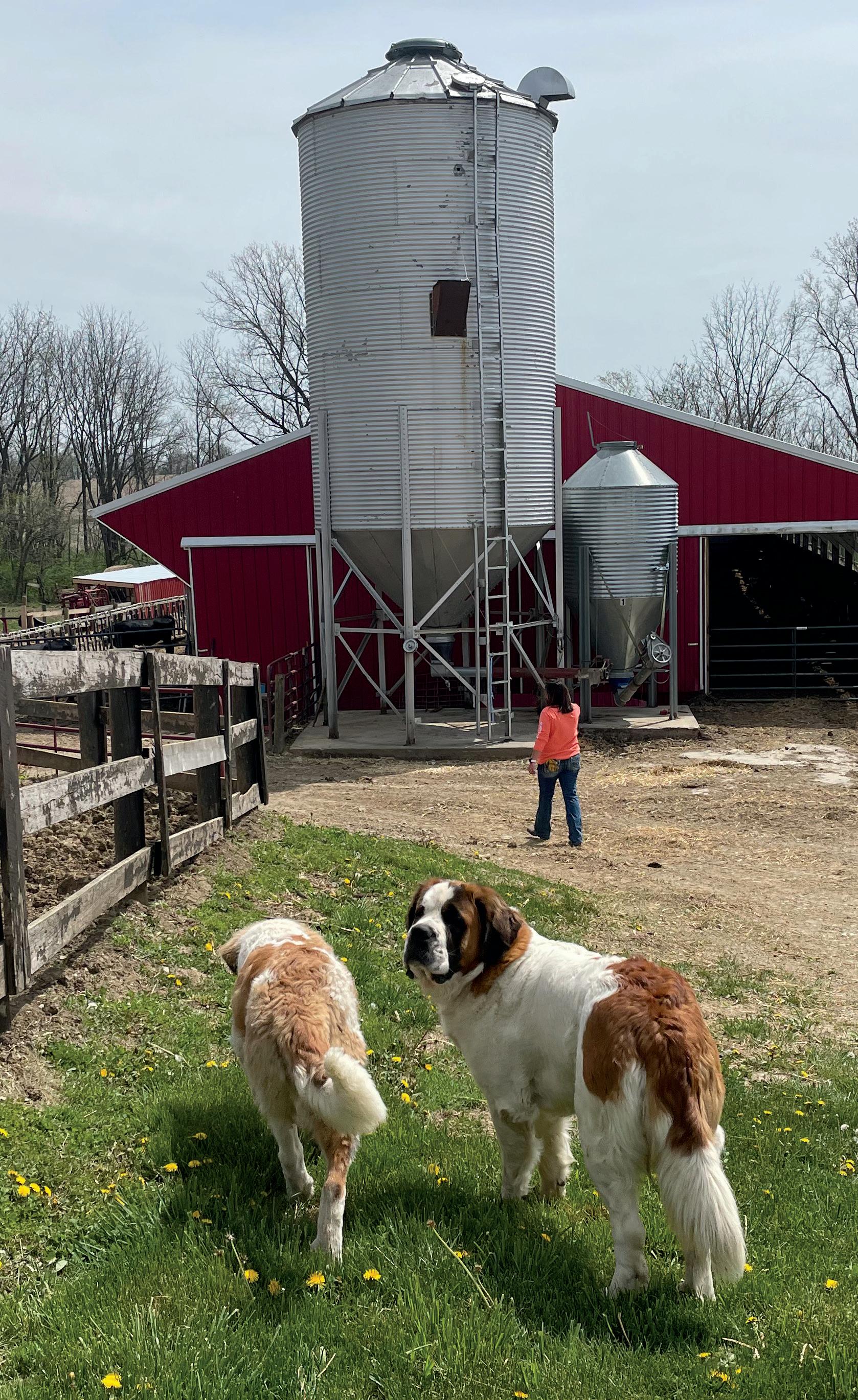

















“We raise everything here. I have a herd of cattle, and I buy weaned calves each year in the fall, along with bottlebaby calves from a local dairy to make sure I have enough cattle year-round for meat,” she says. “I also do all of our marketing, I haul live animals in a livestock trailer, and do all of the scheduling with local butchers.”
She delivers meat and eggs twice a month directly to customers at three locations in the Hilliard-DublinColumbus area, and she enjoys interacting personally with them. She also sets up regularly at the Westgate Farmers Market in the Columbus Hilltop area.







“I want to be the face of what you feed to your family; that’s important to me because I have kids. You’d be surprised how many people don’t know where their food comes from,” she says. “As a producer, my goal is to have the highest-quality product available.”
People place orders online, choosing from a variety of cuts and processed packages. Customers have a window of time to pick up their orders at certain stops. Brandi figures she fills about 40 orders every other week, which is about one or two cows a month.
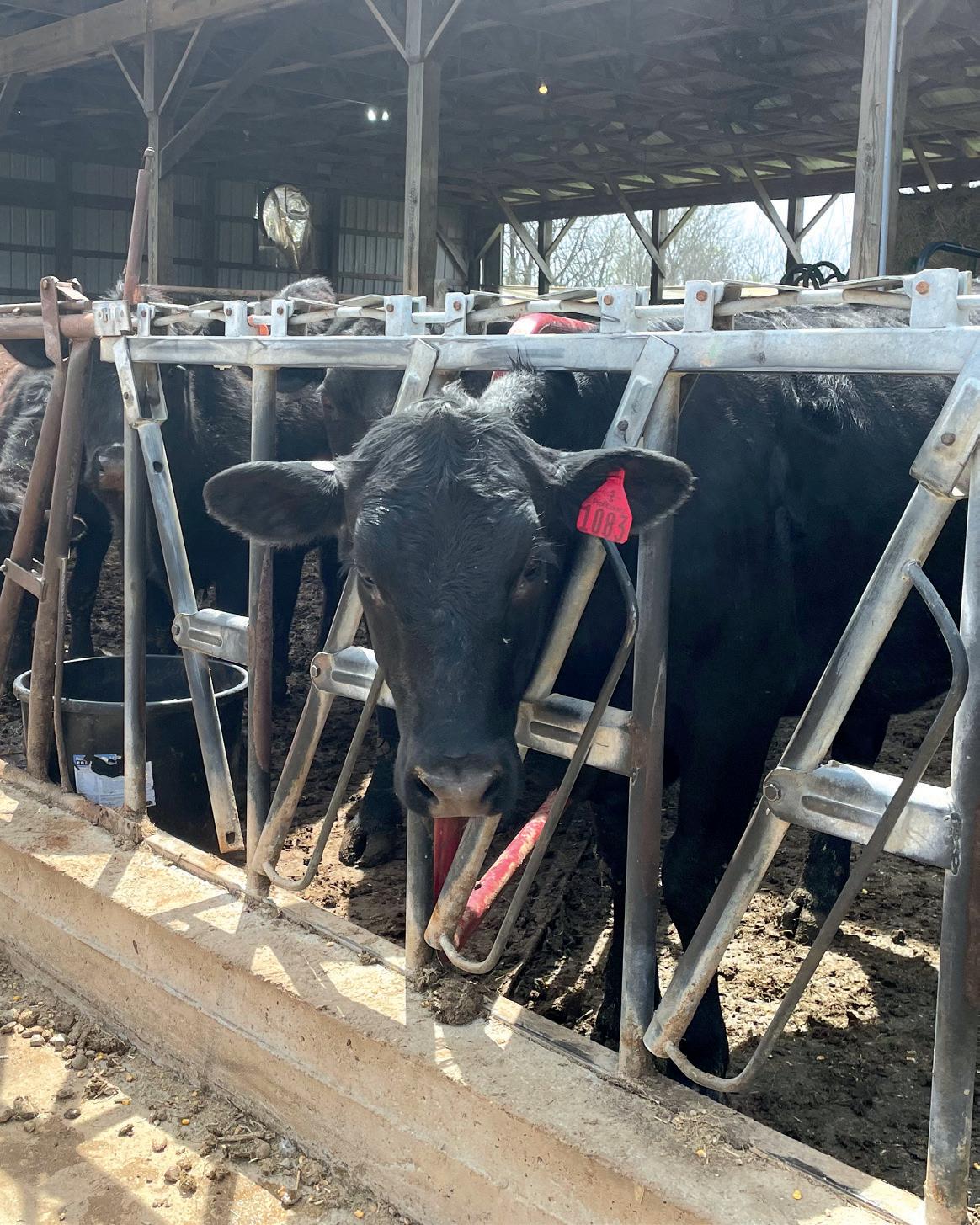


































































She’s quick to admit the cattle are by far her favorite animals on the farm (they’re docile and take a long time to raise) but the chickens, not so much (smelly). Her typical day involves getting the girls on the school bus at 7 a.m., then making rounds with the animals. “I walk through the birds first; they’re the easiest. Then I check on all the cows, the mommas ready to have calves, and the cows in the pasture. Once I make sure everyone’s OK, I mix up their feed, and tackle the rest of the day.”
Brandi and Nick were high school besties who reconnected after college and married on a whim in Las Vegas after a skydiving adventure where he placed a “Will you marry me?” sign at the landing site. The two dove into farming in 2012 , building on his experience working on a dairy farm and her work at an agriculture cooperative. Along the way, they raised dairy heifers and bottle-babies, and she learned to drive a semi-truck. Today, the couple, her brother, and her brother’s wife also own a manure-handling and forage-chopping business, and the guys plow snow in Columbus in winter.
Between them, the two couples have six young daughters. “It’s important for us to show the kids that hard work never hurt anyone,” Brandi says. “Nick and I are both very hard-headed, very determined, and that’s why it works. We both came from rather poor backgrounds, and our whole goal in life is to make something out of it that we want,” she adds. “He’s self-employed and I’m self-employed. I want to show that the American dream is still attainable. You just have to work for it.”
To order meat from Women That Farm, visit www.wtfmeatsohio.com. Brandi makes deliveries twice a month to three pickup locations in the Columbus area, and customers may also arrange to pick up orders right at the farm in Mechanicsburg.

































































Camp Perry, on the Ohio shores of western Lake Erie a few miles west of Port Clinton, boasts the secondlargest outdoor rifle range in the country. The facility has hosted the National Rifle and Pistol Matches — drawing competitors from around the world to the “world series of shooting sports” — for more than a century.
But few people today realize that for several years during the mid-1940s Camp Perry served a different purpose: It



was a major prisoner-of-war camp, housing some 6,000 German and Italian prisoners in America’s heartland. Today, three-quarters of a century after the last POW marched out of Camp Perry, there is still much tangible evidence of that era remaining, thanks to ongoing historic preservation efforts. For instance, the brick buildings known as “Commercial Row” that house firearms vendor
Continued on page 28
 Most prisoners of war who were detained at Camp Perry in the early 1940s were put to work, including this group of Italian POWs who prepared meals in the camp kitchen.
Most prisoners of war who were detained at Camp Perry in the early 1940s were put to work, including this group of Italian POWs who prepared meals in the camp kitchen.
displays during the National Matches once served as mess halls for the POWs during World War II.
The United States maintained nearly 700 camps, in all but three states, during the war — established to help alleviate the overcrowding of POWs housed in Great Britain. Had just Italian (50,273) and Japanese (3,915) POWs been sent to the U.S., existing American camps could have handled those numbers. But late in the war, as Allied troops began to take control, an additional 371,683 German prisoners began debarking from troop ships onto America’s shores, and the POW prison system was quickly overwhelmed. U.S. military leaders scrambled to find suitable camp locations and construct facilities, and also to train guards, interpreters, and other support personnel; it was a monumental task.
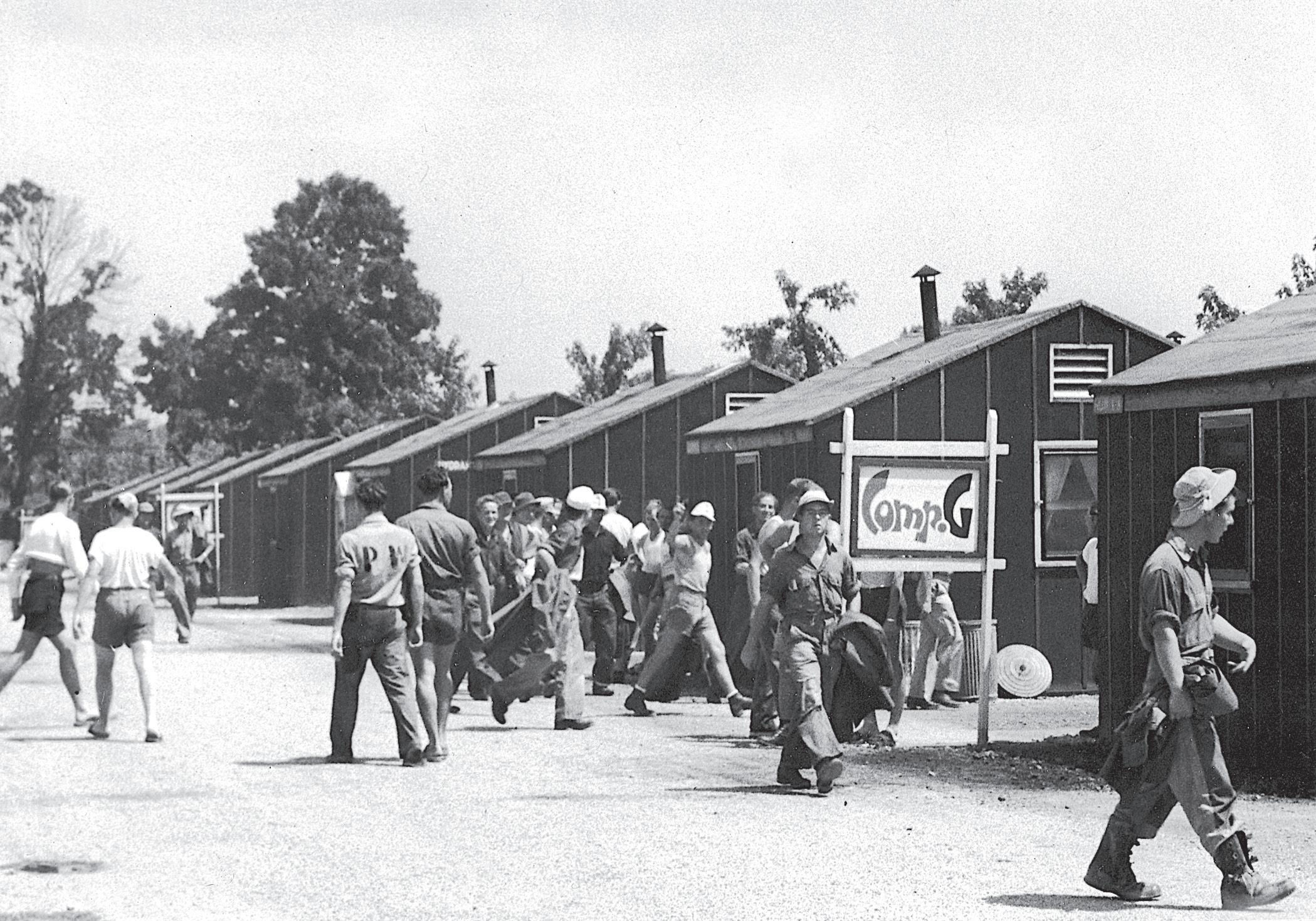
Camp Perry was designated as a main POW base camp in September of 1943; smaller branch camps were located in or near Columbus, Bowling Green, Defiance, Marion, and Wilmington, as well as in Fort Wayne, Indiana. Italian soldiers captured on European battlefields began arriving at Camp Perry right away, followed by German soldiers in 1944. The prisoners were housed in small, wood-framed, tar-paper-covered 16-by-16-foot buildings, groupings of which were called hutments. Each building was a single
story constructed on a concrete slab, double-walled with double-pane windows, heated by a wood-burning stove. Five prisoners were assigned per building. Eleven guard towers and nine-strand barbed-wire fence 9 feet high enclosed the entire encampment.
Prisoners were required to work while at the camp. (Officers were exempt, but many chose to work to alleviate the boredom of prison life.) Prisoners performed the daily routine maintenance of the many buildings, cooked, cleaned, and did other chores as needed. As a result, they earned a small number of coupons per day that they could then redeem at the prison camp PX, or Post Exchange.
According to numerous accounts, German prisoners did not think much of the American 3 2% alcohol beer they could purchase at the camp PX for 10 cents per bottle — it was just too bland and mild for their tastes. However, they did like the Coca-Cola that sold for 4 cents, and they bought many a pack of Spuds cigarettes, which cost 14 cents.
POWs were also often pressed into service outside the camp, which was not always popular with local civilians.
POWs even worked at two Ohio hospitals, Crile General in Parma and Fletcher General in Cambridge. Others served as farmhands in northwest Ohio or worked in
factories alongside American civilian women whose husbands and sons were fighting overseas. The Americans also watched as the prisoners were provided three square meals a day — often eating food that citizens couldn’t readily obtain because meats and canned goods were subject to strict rationing.
Some local civilians took the food disparity issue, and the fact that they had a POW camp in their backyard, philosophically, and even went out of their way to interact with the prisoners, while others refused to have anything to do with them. One Ohio resident, who chose to get to know some of the men “behind the wire” at Camp Perry, commented, “You could tell the Germans from the Italians because the Italians were laid-back and so friendly, while the Germans were stoic, stern, and did not talk much, although they worked hard.”
After May 8, 1945, V-E Day, which marked the end of World War II in Europe, American POW camps began to empty almost immediately as prisoners were sent home to their native countries.

Interestingly, a number of German and Italian prisoners eventually returned to America to live permanently and even become citizens. Impressed by how relatively well they were treated as POWs, they wanted to experience the opportunities and freedoms they had seen while in America that their home countries did not offer.
During the time Camp Perry housed prisoners of war during the Second World War, some POWs worked off-site — employed at area businesses, or planting and harvesting crops at local farms. Of course, they were overseen by armed camp guards. Well, at least most of the time.
Kenny Libben (above), curator of the Cleo Redd Fisher Museum in Loudonville, relates a story handed down from his grandfather:

“My family owns a farm adjacent to Camp Perry, and during WWII, our farm included a large commercial orchard.
“My grandfather, who was a young boy at the time, told me stories about the POWs: how they would be marched from the camp to the farm to help pick fruit during harvest and surprisingly just left there. The guards would drop them off in the morning and then go back to the camp for the day, leaving my grandpa and great-grandpa to keep an eye on them. He said the POWs always behaved well, so escape wasn’t much of a concern, but one day the guards forgot to come back to get them.
“My family ended up feeding all the men supper, and eventually my grandfather had to go to the camp to remind the guards that there were a few dozen Nazis sitting in our front yard and would someone please come get them.”
Many of the buildings that housed prisoners at Camp Perry still stand today.Bowling Green United Home Comfort (419) 352-7092
unitedhomecomfort.com
Canal Winchester
Kessler Htg & Clg (614) 837-9961
kesslerheating.com
Chillicothe
Accurate Htg & Clg (740) 775-5005
accurategeothermal.com
Coldwater
Ray’s Refrigeration (419) 678-8711
raysrefrigeration.com
Columbus Geo Source One (614) 873-1140
geosourceone.com
Defiance
Schlatters Plbg & Htg (419) 393-4690
schlattersgeothermal.com
Dresden Federal Htg & Clg (740) 754-4328
federalheating.com
Findlay
Knueve & Sons Inc. (419) 420-7638
knueve.com
Gahanna Custom A/C & Htg (614) 552-4822
customairco.com/ geothermal
Groveport
Patriot Air (614) 577-1577

patriotair.com
Holgate Holgate Hardware (419) 264-3012
Kalida
Knueve & Sons Inc. (419) 420-7638
knueve.com
Sarka Electric (419) 532-3492
sarkaelectric.com
Lancaster
Fairfield Heating (740) 653-6421
fairfieldgeothermal.com
Mansfield Eberts Energy Center (419) 589-2000
ebertsheatingandcooling. com
Marion Wenig’s Inc. (740) 383-5012 wenigsinc.com
Medina Sisler Heating (330) 722-7101
sislerwaterfurnace.com
Mt. Vernon Cosby Htg & Clg (740) 393-4328
cosbyhc.com
New Knoxville New Knoxville Supply (419) 753-2444
newknoxvillesupply.com
Newark Hottinger Geothermal (740) 323-2330
hottingergeothermal.com
Sidney Lochard Inc. (937) 492-8811
Sunbury
Westin Air (614) 794-1259
geothermalcentralohio.com
Toledo
Overcashier & Horst (419) 841-3333
ohcomfort.com
Waverly Combs Htg & A/C (740) 947-4061 combsgeopro.com
Wellington
Wellington Indoor Comfort (440) 647-3421
Many homeowners have come to accept that a noisy A/C is a fact of life. But with WaterFurnace, you don’t have to settle.






Nothing can disrupt a perfect summer afternoon in your backyard more than a loud air conditioner. Geothermal users are never disturbed from outside HVAC noise because there’s no outdoor equipment to make any. All the complicated work takes place underground—out of earshot. With WaterFurnace, your peace and quiet is assured. To learn more, contact your local WaterFurnace dealer today.

Geothermal is the only renewable that provides reliable operation 24 hours a day, 7 days a week, 365 days a year.




























and a car and motorcycle show. 419-673-4131 or www. facebook.com/KentonHistoricCourthouseDistrict.
JUL. 15 – Malinta Days Festival, Henry County, Monroe Twp. Fire Station, 8931 Co. Rd. K-2, Malinta, 10 a.m.–4 p.m. Classic car show, chicken BBQ, axe throwing, entertainment, inflatables, live auction, flea market, wagon and train rides, and more. 419-966-9909 or www.facebook.com/Malintafest.

AUG. 3–6 – Northwest Ohio Antique Machinery Association Show, Hancock Co. Fgds., 1017 E. Sandusky St., Findlay. Featuring John Deere tractors and engines, along with arts and crafts, consignment sales, flea market, truck and tractor pulls, tractor square dance, and other fun activities. www.facebook. com/NorthwestOhioAntiqueMachineryAssociation.
THROUGH JUL. 21 – “All Together Now”: Summer Library Program, Shelby County Libraries, in Anna, Botkins, Ft. Loramie, Jackson Center, Russia, and Sidney. Themed programs, special guests, crafts, snacks, and more, plus prizes. Sign up at any of our six locations. www.shelbycountylibraries.org.
THROUGH AUG. 4 – Limaland Motorsports Park Races, 1500 Dutch Hollow Rd., Lima, 7:30–10:30 p.m. Sprints, UMP Modifieds, Thunderstocks, and more! Pit gates open at 4:30 p.m., grandstand gates at 5 p.m., warmup laps begin at 6:30 p.m. See website for updated information. www.limaland.com.
THROUGH SEP. 10 – NWORRP Museum Summer Hours, Northwest Ohio Railroad Preservation Inc., 12505 Co. Rd. 99, Findlay, Sat./Sun. 1–4 p.m. $3; 12 and under, $2. Museum tours, quarter-scale train rides, model train displays, games, play area, and more. 419423-2995, www.nworrp.org, or www.facebook.com/nworrp.
THROUGH OCT. 14 – The Great Sidney Farmers Market, Shelby County Court Square, 100 E. Court St., Sidney, Sat. 8 a.m.–noon. Fresh produce, baked goods, jams and jellies, crafts, plants, and flowers. 937-658-6945 or www.sidneyalive.org.
JUL. 15 – Eats on the Street, downtown Kenton. 5–10 p.m. Food trucks, live music featuring multiple bands, craft and draft beer, local wine, kids’ fun zone,
JUL. 20 – “Croce Plays Croce,” Veterans Memorial Civic and Convention Center, #7 Town Square, Lima, 7:30 p.m. A.J. Croce presents a special night of music featuring a complete set of classics by his late father, folk and rock singer-songwriter Jim Croce; some of his own tunes; and songs that influenced both him and his father. 419-224-1552 or www.limaciviccenter.com.
JUL. 22 – Vernon McIntyre’s Appalachian Grass, Ottawa Metro Park, 2632 Ada Rd., Lima, 7–8 p.m. Free. 419-221-1232, 419-223-1025, or www.jampd.com/ parks-facilities/ottawa-metro-park.
JUL. 29 – Family Fun Day: “Mid-Summer Celebration,” Northwest Ohio Railroad Preservation Inc., 12505 Co. Rd. 99, Findlay, 1–4 p.m. $5. Enjoy games, quarter-scale train rides, bounce house, and other fun activities. 419-423-2995, www.nworrp.org, or www.facebook.com/nworrp.
JUL. 30 – Westminster Music in the Park, 6825 Faulkner Rd., Westminster, 11 a.m.–4 p.m. Free. Annual Christian music festival, with free food/beverages and a car show. Bring your lawn chairs. www. musicinthepark.info.
AUG. 2 – Down on the Farm Story Time, Proving Ground Farm, 5670 E. Twp. Rd. 138, Tiffin, 10 a.m. Stories and activities are geared for preschoolage children and focus on farming and nature in a picturesque outdoor setting. Families welcome! 419447-7073, www.conservesenecacounty.com, or follow Seneca Conservation District on Facebook.
AUG. 3 – Concert: All-4-One and Naturally 7, Greater Lima Region Park and Amphitheatre, Pangle Pavilion, 128 E. Spring St., Lima, 7:30 p.m. $25–$55. www. limaciviccenter.com/panglepavilion.
AUG. 4 – Concert: Al Jardine, Greater Lima Region Park and Amphitheatre, Pangle Pavilion, 128 E. Spring St., Lima, 7:30 p.m. $25–$55. Enjoy an evening of music by one of the founding members of the Beach Boys. www.limaciviccenter.com/panglepavilion.
AUG. 5 – Annual Car Show: “Car Tunes on Main,” downtown Findlay, 1–4 p.m. Free. Registration noon–1 p.m. ($15 fee). All vehicles welcome! Awards, raffles, 50/50 drawing, vendors, and food. All proceeds benefit Open Arms Domestic Violence and Rape Crisis Services. lawebb@dalawinc.com or www.flagcitycorvettes.com/car-tunes-2023
AUG. 5 – Defiance County Hot Air Balloon Festival, 20399 Airport Rd., Defiance. $10 per car. Tethered hot air balloon rides, marketplace, food trucks, inflatables and kids’ rides, live music, and more. 419-782-3510 or www.defianceballoonfest.com.
AUG. 10–12 – Lincoln Highway “Buy-Way” Yard Sale, locations along and near U.S. 30 across the state, including Crawford, Wyandot, Hardin, Hancock, Allen, and Van Wert counties. www.historicbyway.com.
AUG. 10–13 – St. Marys SummerFest Bicentennial Celebration, Skip Baughman Complex on East South Street, St. Marys. See website for schedule. Free. Entertainment, games, National Guard obstacle course, food and beer, rides, beard contest, parade Sat. 4:30 p.m., fireworks Sat. night. 419-300-4611, info@ stmarysohio.org, or www.stmaryssummerfest.com.
AUG. 13 – Sunday Sunset Jazz and Art Fest, Towpath Trail, downtown Grand Rapids, 2 p.m. to dusk. Free. Music, food, art, adult beverages. Bring lawn chairs; NO coolers. Rain date: Aug. 20 www.grandrapidsartscouncil.org.
JUL. 28–30 – Upper Ohio Valley Italian Heritage Festival, Water Street, Wheeling, Fri./Sat. 11 a.m.–midnight, Sun. 11 a.m.–6 p.m. Celebrating our Italian heritage with live music, entertainment, and, of course, great food! /www.italyfest.org.


distilleries, a ghost trek, a whiskey museum tour, and an overnight stay at Hampton Inn in Bardstown. 419-8536016 or www.ormaco.org/upcoming_events.
JUL. 15–16 – Revolution on the Tuscarawas, Fort Laurens, 11067 Fort Laurens Rd. NW, Bolivar, Sat. 10 a.m.–5 p.m., Sun. 10 a.m.–4 p.m. $10; 12 and under free. Revolutionary War battle reenactment with the Brigade of the American Revolution. Demos in 18th-century cooking, artillery, music, and medicine. 330-874-2059 or www.fortlaurensmuseum.org.
online entry fee. Proceeds benefit the Love Center Food Pantry. https://runsignup.com/Race/OH/Millersburg/ MillersburgFoodRun.
JUL. 31–AUG. 6 – Columbiana County Fair, 225 Lee Ave., Libson. 330-424-5531 or www. columbianacountyfair.org.

JUL. 31–AUG. 6 – Medina County Fair, 720 W. Smith Rd., Medina. 330-723-9633 or www.medinaohiofair.com.
THROUGH JUL. 29 – “Susan Cook’s Award-Winning Quilts,” McCook House Museum, Carrollton, Fri./Sat. 10 a.m.–5 p.m. $3. Susan has completed more than 200 quilts and has given away machine-made quilts to veterans, cancer patients, and many others. This exhibit features hand-sewn projects only. 330-437-9715 or kathorn4120@gmail.com.
THROUGH AUG. 3 – Fort Steuben Summer Concert Series, Fort Steuben Park, 120 S. 3rd St., Steubenville, Thur. 7–9 p.m. Free. Bring a blanket and picnic basket and enjoy a variety of live musical performances. 740283-1787 or www.oldfortsteuben.com.
THROUGH OCTOBER – Quilt Exhibit: “History in Pieces,” Bimeler Museum, Historic Zoar Village. Featuring fine quilts from the National Quilt Museum in Kentucky (including one from an Ohio quilter) and Zoar-made quilts from the 19th century. See website for museum schedule. 800-262-6195 or www. historiczoarvillage.com.
JUL. 1–3 – Village of Spencer Bicentennial Celebration, Firestone Park, Spencer. Ice cream social, kids’ games, vintage baseball game, concert, dinners, movies, and more. Hours vary. 330-441-1546
JUL. 14–15 – Kentucky Bourbon Trail Bus Trip, departing from Buehler’s River Styx in Medina, Fri. 6 a.m., and returning Sat. 6:30 p.m. $320–$330. Trip to Bardstown, KY, includes tours and tastings at two
JUL. 21 – Joe Leaman and Friends: “An Evening of Steel Drum,” John Streeter Garden Amphitheater, 2122 Williams Rd., Wooster, 6:30 – 8:30 p.m. Bring your lawn chairs, blankets, and picnics to enjoy this free concert. Rain location: Fisher Auditorium, 1680 Madison Ave. Reservations recommended by registering online at www.ormaco.org or calling 419-853-6016
JUL. 21–22 – “Wine on Rails,” Lorain & West Virginia Railway, 46485 St. Rte. 18, Wellington, Fri. 7 p.m., Sat 6 p.m. Must be 21 or over. $38 50 ticket includes wine; $25 for designated driver ticket. Ride lasts about 11⁄2 hours. Enjoy tasting a variety of wines from Matus Winery. 440-647-6660 or www.lwvry.org.
JUL. 29–30 – Holy Fair and Festival, Brighton Congregational Church, 22086 St. Rte. 511, Wellington. Free. Sat. 12–10 p.m., petting zoo, craft show, bounce houses, games, food trucks, live music, and Christian speakers. Sun. 9 a.m., food truck starts serving breakfast; outdoor worship service at 11 a.m. For more information, contact John Burgess at 419-651-9622
JUL. 29-30 – Zoar Antiques Show and Artisan Tent, 198 Main St., Zoar, 10 a.m.–5 p.m. $12; 12 and under free. More than 60 dealers of high-quality country antiques. Includes juried artisan showcase, contemporary crafts, historical demonstrations, and museum tours. 800-262-6195 or www. historiczoarvillage.com.
JUL. 30 – Millersburg Food Run 5K/10K and 1-Mile, Hipp Station, 62 Grant St., Millersburg, 8 a.m. $8-$40
AUG. 4 – First Fridays on Fourth, 155 N. 4th St., Steubenville, 6–10 p.m. Free. Art, crafts, games, food trucks, live entertainment, and activities to stimulate the imagination. www.theharmoniumproject.org/ first-Fridays.
AUG. 4–6 – Twins Day Festival, Glenn Chamberlin Park, 10260 Ravenna Rd., Twinsburg. The world’s largest annual gathering of twins features contests, games, parade, talent show, and other entertainment. 330-425-3652 or www.twinsdays.org.
AUG. 5 – “Jazz Under the Stars”: Nick Puin Band, Uptown Park, Medina, 7–9 p.m. Bring your lawn chairs, blankets, and picnics to enjoy this free concert. Rain location: St. Paul’s Episcopal Church, 317 E. Liberty St. Reservations recommended by registering online at www.ormaco.org or calling 419-853-6016.
AUG. 10–12 – Lincoln Highway “Buy-Way” Yard Sales, locations along and near historic U.S. 30 across the state, including through Columbiana, Stark, Wayne, Ashland, and Richland counties. www.historicbyway.com.
AUG. 12 – Last Stop Willoughby Festival, downtown Willoughby. Free. Enjoy shopping at the outdoor market, kids’ activities in Point Park, the annual Chalkfest, and the annual parade. Continuous screenings of the Twilight Zone episode titled “A Stop at Willoughby” will play 10 a.m.–4 p.m. www.heartofwilloughby.com.
AUG. 13 – Cliff Habian Trio, Wadsworth Public Library, 132 Broad St., Wadsworth, 2–3 p.m. Free. Delight in American Songbook classics. Reservations recommended by registering online at www.ormaco.org or calling 419-853-6016
9 a.m.–noon; Apr. 20–Nov. 23, Wed./Sat. 9 a.m.–noon. Voted Ohio’s #1 favorite farmers market! 740-593-6763 or www.athensfarmersmarket.org.
THROUGH DECEMBER – Athens Art Market, Athens Community Center, 701 E. State St., Athens, Sat. 9 a.m.–noon. Members of Athens Art Guild offer handmade and juried arts including pottery, live edge furniture, fiber arts, paintings, glassware, jewelry, wood, and much more. For more information, email athensartguildevents@gmail.com.
JUL. 29–30 – Frankfort Sunflower Festival, downtown Frankfort, Sat. 10 a.m.–10 p.m., Sun. 10 a.m.–6 p.m. Free. Concessions, car show, antique tractors, games, live music, parade, and, of course, a sunflower contest! www.sunflowerfestival.net.
AUG. 5 – Lewisville Community Carnival and Car Show, 33261 Back St., Lewisville. Enjoy games, vendors, country store, live music, bounce house, and other fun events. Best chicken dinners around 4 p.m., with parade to follow at 6 p.m. Car show registration starts at 9 a.m.; awards at 3 p.m. 740-228-1327 or follow Lewisville Community Center on Facebook.
AUG. 5–12 – Ross County Fair, Ross Co. Fgds., 344 Fairgrounds Rd., Chillicothe. 740-775-5083 or http://www.rosscountyfair.com.
THROUGH SEP. 3 – Tecumseh! Outdoor Drama, Sugarloaf Mountain Amphitheatre, 5968 Marietta Rd., Chillicothe, Mon.–Sat. 8 p.m. $30–$50. The epic life story of the legendary Shawnee leader as he struggles to defend his sacred homelands in the Ohio country. www.tecumsehdrama.com.
THROUGH DECEMBER – Athens Farmers Market, Athens Community Center, 701 E. State St., Athens, Sat.
AUG. 3–5 – Roy Rogers Festival, Anerican Legion Post 23, 705 Court St., Portsmouth. Meet Roy Rogers’ family and celebrity guests, and enjoy music, food, and entertainment. https://royrogersfestival.com.
AUG. 4–5 – Deerassic Classic Giveaway, Deerassic Park Education Ctr., 14250 Cadiz Rd./U.S. 22, Cambridge. Outdoor exhibitors, stage shows, raffles, prizes, food, and entertainment. Purchase tickets at 740-435-9500 or https://deerassic.com.
AUG. 11–13 – Salt Fork Arts and Crafts Festival, Cambridge City Park, Cambridge, Fri. 12–7 p.m., Sat. 10 a.m.–7 p.m., Sun. 10 a.m.–4 p.m. Free. Award-winning artists and craftsmen, live music, Appalachian heritage art demonstrations, Ohio-made products, concession food, and much more. 740-630-8935 or www. saltforkfestival.org.
AUG. 10–13 – Rivers, Trails, and Ales Fest, Muskingum Park, 300 block of Front St., Marietta. A full weekend of paddling, road and mountain biking, hiking, trail running, and enjoying regional craft beers in Ohio’s #1 destination for outdoor adventure: Marietta! www.facebook.com/RTAfest.
of steam engines, antique tractors, and gas engines, featuring International Harvester. Fun for the whole family. 614-270-0007, mvstashow@gmail.com, or www. miamivalleysteamshow.org.
JUL. 13, AUG. 10 – Inventors Network Meeting, The Point at Otterbein University, 60 Collegeview Rd., Westerville 43081, 7 p.m. Educational presentations and discussion about the invention process. Zoom meetings
Jul. 20 and Aug. 17 at 7 p.m. 614-470-0144 or www. inventorscolumbus.com.
activities, fan-cooled dining areas, and a beer and wine garden. 614-270-5053 or www.bluesandribfest.com.
AUG. 4–5 – Y-Bridge Arts Festival, Zane’s Landing Park, Zanesville, Fri. 2 p.m. till dark, Sat. 11 a.m. till dark. Free. Unique art vendors, live music, food trucks, beer garden, and children’s activities. http:// ybridgeartsfestival.com.
AUG. 4–6 – Dublin Irish Festival, Coffman Park, 5600 Post Rd., Dublin. $20–$30, 12 and under free. www. dublinirishfestival.org.
THROUGH JUL. 16 – CAPA Summer Movie Series, Ohio Theatre, 55 E. State St., Columbus, Wed.–Sun. 7:30 p.m., Sun. 2 p.m. $5–$6. America’s longest-running classic film series. 614-469-0939 or www.capa.com.
THROUGH SEP. 30 – Sunbury Farmers Market, Sunbury Town Square, 9 E. Granville St., Sunbury, Sat. 9 a.m.–noon. Offering local handmade, homemade, and homegrown products. 740-513-9192 or sunburyohiofarmersmarket@gmail.com.
THROUGH OCT. 28 – Coshocton County Farmers Market, 22375 Co. Rd. 1A, Coshocton, Sat. 8:30 a.m.–noon. Local fresh produce, baked goods, and artisan crafts at our new location by the Walhonding River. market.manager@coshfarmmarket.org or www. facebook.com/coshoctonfarmersmarket.
THROUGH OCT. 28 – Spring Farmers Market, Adornetto’s, 2224 Maple Ave., Zanesville, Sat. 9 a.m.–noon. Locally grown produce, homemade food, locally raised/processed meat, farm eggs, Ohio cheese, and more. www.zanesvillefarmersmarket.org.
THROUGH OCT. 29 – Rock Mill Days, Stebelton Park at Rock Mill, 1429 Rockmill Place NW, Lancaster, Wed./ Sat. 11 a.m.–2 p.m., Sun. 1–4 p.m. Free. Tour the restored 1824 gristmill and enjoy the view of Hocking River Falls. 740-243-4436 or www.fairfieldcountyparks.org.
JUL. 13–16 – Miami Valley Steam Threshers Association Annual Show and Reunion, Pastime Park, Plain City. $5, 12 and under free. Displays and demos
JUL. 14–16 – Lilyfest, Bishop Educational Gardens, 13200 Little Cola Rd., Rockbridge, Fri. 10 a.m.–6 p.m., Sat. 10 a.m.–5 p.m., Sun. 10 a.m.–4 p.m. Free. Arts and crafts, food, music, educational programs and hikes, and 3 acres of beautiful gardens to explore. 740-9692873 or www.lilyfest.com.
JUL. 16 – Buckeye Comic Con, Courtyard Marriott Columbus West, 2350 Westbelt Dr., Columbus, 10 a.m.–4 p.m. $5; 6 and under free. Comic and toy vendors, guest comic creators, hourly prizes. 330-4623985 or www.harpercomics.com.
JUL. 18, AUG. 1 – Farmers Market, Roseville Branch Library, 41 N. Main St., Roseville, 4–6:30 p.m. Sponsored by the Roseville Branch Library Friends Group. Book sale planned for Jul. 25 740-697-0237 or juanita@muskingumlibrary.org.
JUL. 26–AUG. 6 – Ohio State Fair, Ohio State Fgds., 717 E. 17th Ave., Columbus, Mon.–Fri. 10 a.m.–9 p.m., Sat./Sun. 9 a.m.–9 p.m. $10–$12; 5 and under free. 888-646-3976 or www.ohiostatefair.com.
JUL. 27–29 – Goodtime Quilters Guild’s Annual Quilt Show, Ohio Christian University Maxwell Center, 1476 Lancaster Pike, Circleville, Thur./Fri. 9 a.m.–5 p.m., Sat. 9 a.m.–4 p.m. $6 daily, 3-day admission $10 (cash only). 150+ quilt displays, raffle quilt, vendors, door prizes, silent auction, knife and scissor sharpening, and more. www.goodtimequilters.org.
JUL. 28–29 – Canal Winchester’s Blues and Ribfest, historic downtown Canal Winchester. Free. Ohio’s only blues and ribs festival features live blues music, worldclass ribs, a variety of quality non-rib food options, kids’
Collinsville Community Center, 5113 Huston Rd., Collinsville, 7–9 p.m. Free. Lively bluegrass music. Home-style food available on-site. 937-417-8488
JUL. 22–23 – CenterPoint Energy Dayton Air Show, Dayton International Airport, 3700 McCauley Dr., Vandalia, 9 a.m.–6 p.m. $25–$35 plus fee. U.S. Air Force Thunderbirds and full lineup of performers and aircraft displays. www.daytonairshow.com.
AUG. 5 – Dresden Melon Festival, Dresden. $1–$2 Games, kids’ activities, food, craft show, live music, and fun competitions, including the Melon Derby. See website for schedule of events. 740-607-7804, 740252-2651, or www.dresdenmelonfestival.com.
AUG. 10–12 – All Ohio Balloon Fest, Union Co. Airport, 15000 Weaver Rd., Marysville. Cash only! Hot air balloons, aerial entertainment and rides, kids’ area, food, and live music, including the Beach Boys and the Wallflowers. Bring your own lawn chairs. 937-243-5833 or www.allohioballoonfest.com.
AUG. 11 – Concert: McGuffey Lane, Public Square, downtown Mount Vernon, 8:30 p.m. www.mvac.org.
AUG. 11 – Pickerington Wizard Faire, Victory Park, 75 Lockville Rd., Pickerington, 4–8:30 p.m. Part of Wands & Wizards Weekend, this free community festival will feature games, food, music, and more. Costumes are welcome at this “magical” event. www. pickeringtonvillage.com.
AUG. 12 – Books in the Barn, 5530 Radnor Rd., Radnor, 9 a.m.–3 p.m. Family-friendly authors, arts and crafts, food, music, and more. www.maryrodman.com.
AUG. 12 – Concert: Starship featuring Mickey Thomas, Public Square, downtown Mount Vernon, 8:30 p.m. www.mvac.org.
AUG. 12 – Union County Master Gardeners Annual Plant Sale, Union Co. Fgds., 845 N. Main St., Marysville, 8 a.m.–noon. Sun and shade perennials, native plants, shrubs and trees, grasses, bulbs, and daylilies at reasonable prices. 937-644-8117 or https://union.osu. edu/program-areas/master-gardener-volunteers.
AUG. 5 – Family Program: “Legend and Storytelling Hike,” Wagers Memorial Park (Devil’s Backbone), 1301 OH-725 W., Camden, 1–3 p.m. Free. Led by Rainbow Eagle, an Oklahoma-Choctaw American Indian naturalist and teacher. 937-962-5561, pcpdevents@ gmail.com, or www.preblecountyparks.org.
THROUGH AUG. 30 – Bluegrass Wednesdays, Vinoklet Winery, 11069 Colerain Ave., Cincinnati, Wed. 6:30–8:30 p.m. Dinner, wine, and free entertainment by Vernon McIntyre’s Appalachian Grass. Reservations recommended. 513-385-9309, vinokletwinery@fuse. net, or www.vinokletwines.com.
THROUGH AUG. 31 – Uptown Music Concert Series, Uptown Park, Oxford, Thur. 7 p.m. Free. 513-523-8687 or www.enjoyoxford.org.
JUL. 21 – Bluegrass Night, Fibonacci Brewing Company, 1445 Compton Rd., Cincinnati, 7–9 p.m. Free. Lively bluegrass music by Vernon McIntyre’s Appalachian Grass, craft beers in the Beer Garden, food truck. 513-832-1422 or http://fibbrew.com.
JUL. 28, AUG. 11 – Vernon McIntyre’s Appalachian Grass, Butler County Bluegrass Association,
JUL. 28–30 – Annie Oakley Festival, Darke Co. Fgds., 800 Sweitzer St., Greenville. Honoring Darke County’s most famous daughter. Shooting contests, fast draw competitions, bullwhip exhibitions, food, car show, and more. www.annieoakleyfestival.org.
JUL. 29–30 – Gathering at Garst, 205 N. Broadway, Greenville, Sat. 10 a.m.–8 p.m., Sun. 11 a.m.–5 p.m. Living history encampment, antiques, entertainment, arts and crafts, food vendors. 937-548-5250 or www. gatheringatgarst.com.
JUL. 29–30 – History Alive at the Johnston Farm, 9845 N. Hardin Rd., Piqua, Sat. 10 a.m.–5 p.m., Sun. 10 a.m.–4 p.m. $5–$10, under 6 free. See life as it really was in Ohio from 1745–1862. Visit the Johston home, tour the Indian and Canal Museum, and ride on the canal boat General Harrison of Piqua 800-7522619 or www.johnstonfarmohio.com.
AUG. 3–6 – World’s Longest Yard Sale, locations along U.S. 127 through Greenville. www.127yardsale.com.
AUG. 5 – Family Program: “Shelter in the Woods,” Wagers Memorial Park (Devil’s Backbone), 1301 OH725 W., Camden, 1–3 p.m. Free. Led by naturalist and teacher Bev Holland. 937-962-5561, pcpdevents@ gmail.com, or www.preblecountyparks.org.
AUG. 5 – Biergarten: “Rock the Haus with 13:30,” Liberty Home German Society, 2361 Hamilton Cleves Rd., Hamilton. Opens 5 p.m.; band plays from 6 to 10 p.m. Food served 5:30–8 p.m. 513-571-6198, www. libertyhome.net, or on Facebook.
AUG. 11–17 – Miami County Fair, Miami Co. Fgds., 650 N. County Rd. 25A, Troy. $6 day pass; under 9 free. 937-335-7492 or www.miamicountyohiofair.com.
AUG. 12 – Adult Program: “All About Birds,” Garber Nature Center, 9691 OH-503 N., Lewisburg, 7 p.m. Presentation by naturalist and nature photographer Tom Hissong 937-962-5561, pcpdevents@gmail.com, or www.preblecountyparks.org.
My








Wren’s first bite of cotton candy at the Brown County Fair!

Send us YOUR picture!
Fried cheese sticks for the queen: my granddaughter, Paige!


My











and his
enjoy
Family members have worked at Tracey’s Concessions at the Ohio State Fair since 1956! Sadly, Grandpa passed earlier this year, but his legacy lives on!

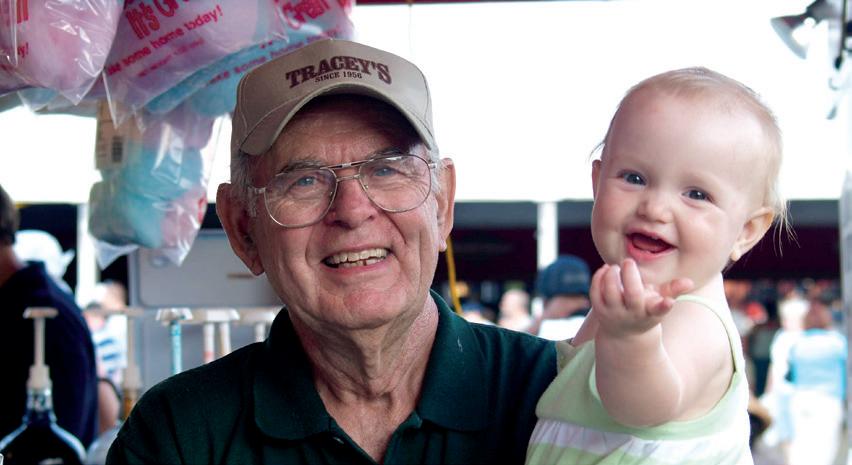

Our daughters share a lemonade at the Lorain County Fair, a family highlight for generations.





For October, send “Camping” by July 15. For November, send “Raking leaves” by August 15.
Upload your photos at www.ohiocoopliving.com/memberinteractive. Your photo may be featured in our magazine or on our website.
Nancy Mullins, Adams Rural Electric Cooperative member Deanna Robinette, Buckeye Rural Electric Cooperative member daughter, Bridgette, enjoying a caramel apple. Carrie Bussing, North Western Electric Cooperative member Molly Baker, Lorain-Medina Rural Electric Cooperative member Rosie and her corn dog at the fair. Lisa Archer, Logan County Electric Cooperative member grandson, Kayden, friends, James and Olivia, their Icees. Delona Joiner, South Central Power Company member Maggie enjoys our favorite ice cream at the Miami County Fair. Jeasica Woods, Pioneer Electric Cooperative member My granddaughters, Jazmin and Alizah, with cousin Tristan, enjoying ice cream from the ice cream eating contest at the Perry County Fair. Katie Grubba, South Central Power Company member Patricia and Michael Gonda, Lorain-Medina Rural Electric Cooperative membersAs a member of an Ohio electric cooperative, you can help keep the rates stable and affordable by reducing energy use during peak hours on hot summer days. The hottest times of day — usually between 2 p.m. and 6 p.m. — create the highest demand for electricity and when demand is high, so is the price. If we can reduce electric use during peak hours, we can reduce power costs for all the members.



Here are a few simple ways you can help your cooperative “beat the peak” this summer by shifting your energy use to off peak hours:

R







Turn off unnecessary lights and electronics when they aren’t being used
R R R



Run your dishwasher and do laundry early in the morning or later in the evening

Shut blinds and curtains during the day to keep the sun from warming your home













Schedule your pool pump to run during off-peak hours
By adjusting the times you use electricity this summer, you can help us keep stable despite the heat! If we all work together, we all will benefit. That’s the power of cooperation and your electric cooperative membership.










